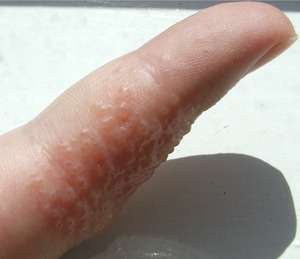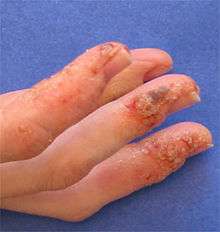Dyshidrosis
| Dyshidrosis | |
|---|---|
| Synonyms | acute vesiculobullous hand eczema,[1] dyshidrotic dermatitis,[2] cheiropompholyx, dyshidrotic eczema, pompholyx, podopompholyx[3] |
 | |
| The characteristic vesicles of dyshidrosis on a finger | |
| Pronunciation | /dɪs.haɪˈdroʊ.sᵻs/[4] |
| Classification and external resources | |
| Specialty | Dermatology |
| ICD-10 | L30.1 |
| ICD-9-CM | 705.81 |
| DiseasesDB | 10373 |
| MedlinePlus | 000832 |
| eMedicine | derm/110 ped/1867 |
| Patient UK | Dyshidrosis |
| MeSH | D011146 |
Dyshidrosis, is a type of dermatitis, that is characterized by itchy blisters on the palms of the hands and bottoms of the feet.[5] The blister are generally one to two millimeters in size and heal over three weeks.[6][7] Redness is not usually present.[6] They; however, often recur.[7] Repeated attacks may result in fissures and skin thickening.[6]
The cause is unknown. Trigger may include allergens, physical or mental stress, frequent hand washing, or metals. Diagnosis is typically based on what it looks like and the symptoms. Allergy testing and culture may be done to rule out other problems.[7] Other conditions that produce similar symptoms include pustular psoriasis and scabies.[6]
Avoiding triggers may be useful as may a barrier cream.[6] Treatment is generally with steroid cream.[7] High strength steroid creams may be required for the first week or two.[6] Antihistamines may be used to help with the itch.[7] If this is not effective steroid pills, tacrolimus, or psoralen plus ultraviolet A (PUVA) may be tried.[6][7]
About 1 in 2,000 people are affected in Sweden. Males and females appear to be affected equally. The first description was in 1873. The name comes from the word "dyshidrotic," meaning "difficult sweating," as problems with sweating was once believed to be the cause.[6]
Signs and symptoms
Small blisters with the following characteristics:
- Blisters are very small (3 mm or less in diameter). They appear on the tips and sides of the fingers, toes, palms, and soles.
- Blisters are opaque and deep-seated; they are either flush with the skin or slightly elevated and do not break easily. Eventually, small blisters come together and form large blisters.
- Blisters may itch, cause pain, or produce no symptoms at all. They worsen after contact with soap, water, or irritating substances.
- Scratching blisters breaks them, releasing the fluid inside, causing the skin to crust and eventually crack. This cracking is painful as well as unsightly and often takes weeks, or even months to heal. The skin is dry and scaly during this period.
- Fluid from the blisters is serum that accumulates between the irritated skin cells. It is not sweat as was previously thought.
- In some cases, as the blistering takes place in the palms or finger, lymph node swelling may accompany the outbreak. This is characterised by tingling feeling in the forearm and bumps present in the arm pits.
- Nails on affected fingers, or toes, may take on a pitted appearance.
 Advanced stage of dyshidrosis on the fingers
Advanced stage of dyshidrosis on the fingers- Palmar dyshidrosis
- Advanced stage of palmar dyshidrosis on the palm showing cracked and peeling skin
 Advanced stage of dyshidrosis on the foot.
Advanced stage of dyshidrosis on the foot. Rim of scale on the palmar surface of the thumb from a resolving dyshidrotic flare
Rim of scale on the palmar surface of the thumb from a resolving dyshidrotic flare
Causes
The exact causes of dyshidrosis are unknown. In 2013, a randomized, double-blind, placebo-controlled cross-over study by the University Medical Center Groningen reported that dyshydrosis outbreaks on the hands increased significantly among those allergic to house dust mites, following inhalation of house dust mite allergen.[8]
Food allergens may be involved in certain cases.[9] Cases studies have implicated a wide range of foods including tuna, tomato, pineapple, chocolate, coffee, and spices among others.[9] A number of studies have implicated balsam of Peru.[9]
Treatment
There are many treatments available for dyshidrosis. However, few of them have been developed or tested specifically on the condition.
- Topical steroids[10] - while useful, can be dangerous long-term due to the skin-thinning side-effects, which are particularly troublesome in the context of hand dyshidrosis, due to the amount of toxins and bacteria the hands typically come in contact with.
- Potassium permanganate dilute solution soaks - also popular, and used to 'dry out' the vesicles,[11] and kill off superficial Staphylococcus aureus,[12] but it can also be very painful. Undiluted it may cause significant burning.[13]
- Dapsone (diamino-diphenyl sulfone), an antibacterial, has been recommended for the treatment of dyshidrosis in some chronic cases.[14]
- Antihistamines: Fexofenadine up to 180 mg per day.[15]
- Alitretinoin (9-cis-retinoic acid) has been approved for prescription in the UK. It is specifically used for chronic hand and foot eczema.[16][17][18] It is made by Basilea of Switzerland (BAL 4079).
See also
- Epidermolysis bullosa - a genetic disorder that causes similar, albeit more severe, symptoms to those of dyshidrosis.
- Dermatitis herpetiformis - a similar condition caused by celiac and often mistaken for dyshidrosis.
References
- ↑ James, William; Berger, Timothy; Elston, Dirk (2005). Andrews' Diseases of the Skin: Clinical Dermatology (10th ed.). Saunders. ISBN 0-7216-2921-0.
- ↑ "Pompholyx". Patient. 2014-02-26. Retrieved 11 August 2016.
- ↑ Rapini, Ronald P.; Bolognia, Jean L.; Jorizzo, Joseph L. (2007). Dermatology: 2-Volume Set. St. Louis: Mosby. ISBN 1-4160-2999-0.
- ↑ "Dyshidrosis". Merriam-Webster Online. Merriam-Webster. 2014. Retrieved 14 April 2014.
- ↑ "What Is Atopic Dermatitis? Fast Facts". NIAMS. November 2014. Retrieved 11 August 2016.
- 1 2 3 4 5 6 7 8 Lofgren, SM; Warshaw, EM (December 2006). "Dyshidrosis: epidemiology, clinical characteristics, and therapy.". Dermatitis : contact, atopic, occupational, drug. 17 (4): 165–81. PMID 17150166.
- 1 2 3 4 5 6 Colomb-Lippa, D; Klingler, AM (July 2011). "Dyshidrosis.". JAAPA : official journal of the American Academy of Physician Assistants. 24 (7): 54. PMID 21748961.
- ↑ Schuttelaar ML, Coenraads PJ, Huizinga J, De Monchy JG, Vermeulen KM (2013). "Increase in vesicular hand eczema after house dust mite inhalation provocation: a double-blind, placebo-controlled, cross-over study". Contact Dermatitis. 68 (2): 76–85. doi:10.1111/j.1600-0536.2012.02172.x. PMID 23046099.
- 1 2 3 Veien, Niels K. (2009-07-01). "Acute and recurrent vesicular hand dermatitis". Dermatologic Clinics. 27 (3): 337–353, vii. doi:10.1016/j.det.2009.05.013. ISSN 1558-0520. PMID 19580928.
- ↑ "eMedicine - Dyshidrotic Eczema : Article by Camila K Janniger". Retrieved 2007-07-10.
- ↑ BIRT AR (March 1964). "Drugs for Eczema of Children". Can Med Assoc J. 90 (11): 693–4. PMC 1922428
 . PMID 14127384.
. PMID 14127384. - ↑ Stalder JF, Fleury M, Sourisse M, et al. (1992). "Comparative effects of two topical antiseptics (chlorhexidine vs KMn04) on bacterial skin flora in atopic dermatitis". Acta Derm Venereol Suppl (Stockh). 176: 132–4. PMID 1476027.
- ↑ Baron S, Moss C (February 2003). "Caustic burn caused by potassium permanganate". Arch. Dis. Child. 88 (2): 96. doi:10.1136/adc.88.2.96. PMC 1719457
 . PMID 12538301.
. PMID 12538301. - ↑ http://www.dermnet.org.nz/dermatitis/pompholyx.html
- ↑ MDContact Dermatitis 2007: 57: 203–210 Journal compilation # 2007 Blackwell Munksgaard CONTACT DERMATITIS Management of chronic hand eczema THOMAS L. DIEPGEN, TOVE AGNER, WERNER ABERER, JOHN BERTH-JONES, FRE´ DE´ RIC CAMBAZARD, PETER ELSNER, JOHN MCFADDEN AND PIETER JAN COENRAADS 1Department of Clinical Social Medicine, Occupational & Environmental Dermatology, University Hospital Heidelberg, Heidelberg 69115, Germany, 2Department of Dermatology, University of Copenhagen, Roskilde Sygehus, 4000 Roskilde, Denmark, 3Department of Dermatology, University of Graz, 8036 Graz, Austria, 4Department of Dermatology, University Hospitals Coventry and Warkwickshire NHS Trust, Coventry CV2 2DX, UK, 5Department of Dermatology, 42055 St Etienne, France, 6Department of Dermatology and Allergology, Friedrich Schiller University Jena, 07740 Jena, Germany, 7St Thomas Hospital, St Johns Institute of Dermatology, London, UK, and 8Department of Dermatology, University Medical Center Groningen, University of Groningen, 9700 RB Groningen, The Netherlands
- ↑ Ruzicka T, Lynde C, Jemec G et al. Efficacy and safety of oral alitretinoin in patients with severe chronic hand eczema refractory to topical corticosteroids: results of a randomised, double-blind, placebo-controlled, multicentre trial. British Journal of Dermatology April 2008; 158(4): 808-817.
- ↑ Dermatology 1999;199:308-312 doi:10.1159/000018280
- ↑ Vol. 140 No. 12, December 2004 Archives of Dermatology Oral Al1itretinoin (9-cis-Retinoic Acid) Therapy for Chronic Hand Dermatitis in Patients Refractory to Standard Therapy Results of a Randomized, Double-blind, Placebo-Controlled, Multicenter Trial Thomas Ruzicka, MD; Frederik Grønhøj Larsen, MD, PhD; Dorota Galewicz, MD; Attila Horváth, MD; Peter Jan Coenraads, MD; Kristian Thestrup-Pedersen, MD; Jean Paul Ortonne, MD; Christos C. Zouboulis, MD; Martin Harsch, PhD; Thomas C. Brown, PhD; Maurice Zultak
External links
| Wikimedia Commons has media related to Dyshidrosis. |
- Images of dyshidrotic eczema at Skinsight
- Pompholyx at DermNet NZ (New Zealand Dermatological Society Incorporated)